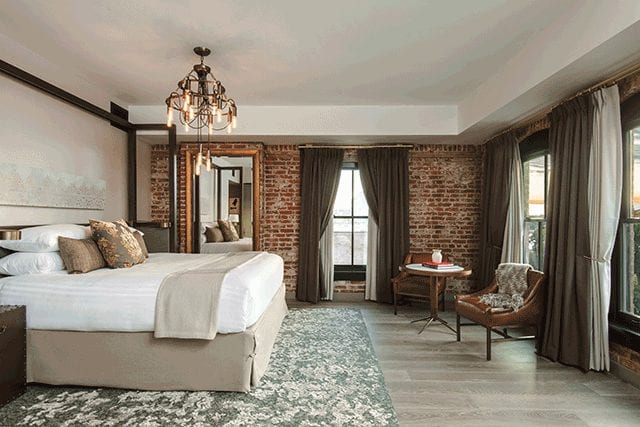Some 13 years ago, when Mario Tricoci first contemplated opening the Elysian Hotel in Chicago, the ultra-luxury market was dominated by fabled names like Four Seasons, Ritz-Carlton, Peninsula, and Mandarin Oriental. While the property he desired to create would also showcase “a refined and thoughtful experience,” he preferred a more easygoing approach guided by “an intuitive nature.” To put this ambitious plan into action, he turned to Kevin Robinson, who he was introduced to by a mutual friend and was then working at the Four Seasons in Alexandria, Egypt, and convinced him to move to the Midwest. The Elysian Hotel made its debut in 2009, and together Tricoci and Robinson forged a new, engaging paradigm in the upscale hospitality sphere.
Launching such a successful, albeit short-lived project—after a capital partner wanted to sell in late 2011, the hotel became the Waldorf Astoria Chicago—proved to the duo that they should continue collaborating on their own terms. That same year they founded Aparium Hotel Group, christening their collection with the Iron Horse Hotel in Milwaukee. The Charmant Hotel in LaCrosse, Wisconsin followed, and then came the Hotel Covington in Northern Kentucky. And within the last year, they bought or opened six unique, independent hotels.

An aubergine, sage, and navy palette complements the masculine aesthetic in Hotel Covington’s tailored lobby from Plume Interiors + Light.
Between Robinson’s extensive hotel experience and Tricoci’s entrepreneurial savvy (he’s the namesake son of the salon magnate), “coming up with ideas that didn’t necessarily make sense in the traditional hospitality world,” the two set out to establish a business model that was markedly different from other hotel groups. They looked at what was not being done (and not being done well) and revisited the lessons they learned from developing and operating the Elysian. “What things did we do really, really well that were sort of revolutionary that we can take with us into a new company?” recalls Tricoci.
Diamonds in the Rough
They decided to focus their attention on thriving smaller cities, underserved and untapped ones that are cluttered with the names of familiar hotel brands. “There’s a lot of culture in these markets. There’s plenty of sophistication. There’s plenty of history,” says Tricoci. The arrival of Aparium happily coincided with the rise of younger people “finding more richness moving into an urban environment,” he adds. In Detroit, for example, the Foundation Hotel (with architecture by local firm McIntosh Poris Associates and interiors by Chicago-based Simeone Deary Design Group) will open this spring. “It’s a major international market but operates much more like a secondary or tertiary one. There’s so much importance in Detroit and things are happening in a real, sustainable way,” explains Tricoci. “We’re grateful we took the risk three years ago when people thought we were absolutely crazy to go into a market that had just filed bankruptcy.” There are also fewer obstacles working in such cities, affording Aparium the chance to bring hotels to life within two years and alleviate the risks of long-term, major developments.
Instead of choosing a city and merely slapping the Aparium name on a building, Robinson says their approach to an independent hotel portfolio was more alluring: “We decided we’d give up the value of the brand and recreate it for every single community we go into.”
Most of the spaces they choose are historic, striking examples of adaptive reuse that strengthen the important connection between hotel and city. For instance, Iron Horse is set in an early 20th-century bedding warehouse; the Charmant in a circa-1890s candy shop; Hotel Covington in the old Coppin’s Department Store; and the Foundation is a revamp of the one-time Detroit Fire Department Headquarters. Yet in the case of the MC, the forthcoming hotel in Montclair, New Jersey, a new build was embraced because it still dovetailed with the Aparium ethos, providing a chance to illuminate the city’s history and robust arts scene. “It has to be an opportunity to make something have soul, and if there’s no opportunity to inject soul into either a new or existing building, we’re not going to do it,” says Tricoci.

European-inspired details and exposed brick define a guestroom at the Simeone Deary Design Group-crafted Charmant Hotel.
United Front
Another core philosophy is a devotion to finding ways to unite transients and locals. “Our business relies on being embraced by the local community because it’s our quickest, most direct path to awareness. For us, it’s how do we become one of them? We do that by continuing to think as entrepreneurs,” says Robinson.
The goal is for locals to act as ambassadors for the distinctive, homegrown experiences Tricoci and Robinson are nurturing. They execute this by seeking out businesses they can “build real, true partnerships with,” says Robinson. Carabello Coffee out of Covington is one example. While finalizing the executive team and chefs for the property, Tricoci and Robinson introduced them to the farmers they met through the coffee giant. “When we talk about local, we think differently and go much deeper,” incorporating local talent at every single opportunity: They’ve joined forces with a brewery on a canned beer, sought out soap from artisans, and turned to tattoo artists for wallpaper designs.
Digging Deep
Designers who work with Aparium must be equally committed. Along with Simeone Deary Design Group, the frequent collaborator behind the Elysian, Charmant, the Foundation, and the Kansas City property in the pipeline, Tricoci and Robinson have also teamed up with a slew of other impressive up-and-coming and veteran firms: Milwaukee-based Kubala Washatko Architects for the Iron Horse Hotel; local firms Plume Interiors + Light and Hub + Weber Architects for the Hotel Covington; Dyami Architecture out of Chestnut Ridge, New York and Long Island City, New York-based dash design for the MC; and ESG Architects for the Hewing Hotel in the firm’s backyard of Minneapolis. Chicago-based Avenir Creative is handling the redo of the Hotel Deco in Omaha, while the reboot of the Madison Hotel in Memphis is the handiwork of Brooklyn’s Home Studios.
It would have been simple, Tricoci says, to recreate the Iron Horse, but he and Robinson would rather challenge designers. “They have to be thoughtful. They have to be on their toes. They have to think creatively and originally with respect to every project,” he says. “Are they willing to roll up their sleeves and dig into the local market and sit with us so that we can express how we think about the opportunity, the asset, the market, the people, the culture?” Serious collaborators take those tenets to heart by doing the research, cultivating a design that respects the original vision, and translating that into a masterpiece.


Housed inside a century-old warehouse, the Hewing Hotel in Minneapolis by ESG Architects features a Scandinavian-inspired rustic design, as seen in Tullibee restaurant, outfitted with exposed timber, brick, and original industrial elements, and the wood-clad reception area.
Consider the Hewing. As a nod to the immigrants who once logged the area, the hotel is crowned with a rooftop sauna where a butler-like sauna master greets guests with a hot buttered rum. They can “sit in the hot tub and enjoy the beauty of the outside even when it’s snowing,” says Robinson. A seemingly straightforward recreational amenity is, in fact, a celebration of both the communal Scandinavian ritual and the city’s longtime all-seasons passion for outdoor activities.
Local architects, mill workers, and craftspeople like ceramicists who fashion lighting fixtures all work hand in hand with designers. Rather than having all the FF&E developed, constructed, or manufactured outside the U.S., Aparium tries to stay local. But, says Robinson, this can prove expensive, forcing them to balance their budget through a different lens: “We end up in a position where we know the product we want, and then [everything] ends up costing us more than what we originally expected.”
Power of Three
Tricoci and Robinson enjoy an unusual sense of freedom to make such decisions as they own outright a handful of their hotels. They make investments in others, structuring partnerships with like-minded people to get involved with projects in different ways, and then solely operate the remaining properties in their portfolio. Whatever their involvement, they usually like to be involved in the concepting, branding, or positioning of the hotel. For the recently restored Pontchartrain Hotel in New Orleans, from Chicago-based AJ Capital Partners, the set up was a bit different as Aparium was brought in a few months before opening solely for the management, without any input. “They’re saving a historical asset. It’s in a community that we love and it’s in line with everything that is important to us,” says Tricoci. Knowing and respecting AJ Capital for quite some time (they shared an office at one point), he felt they would have done something “very similar. So it actually meets what we do very well.”
And the duo isn’t slowing down anytime soon. Next on the boards are properties in Tampa, Florida; Tempe, Arizona; Birmingham, Michigan; and Des Moines, Iowa. “We’re not building something to jump out quickly,” says Robinson. “We’re building something that we can have control of and enjoy doing for the rest of
our lives.”


